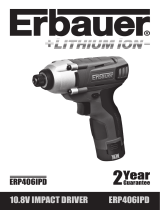
15
Avertissements généraux concernant la sécurité des outils électroportatifs
risque de blessure corporelle.
Évitez les démarrages intempestifs. Assurez-vous
que l’interrupteur est dans la position arrêt (Off)
avant de brancher l’outil dans une prise de courant
et/ou un bloc-piles, de le ramasser ou de le trans-
porter. Le transport d’un outil électroportatif avec le
doigt sur la gâchette ou le branchement de cet outil
quand l’interrupteur est en position de marche (ON) est
une invite aux accidents.
Enlevez toutes les clés de réglage avant de mettre
l’outil électroportatif en marche. Si on laisse une clé
sur une pièce tournante de l’outil électroportatif, il y a
risque de blessure corporelle.
Ne vous penchez pas. Conservez toujours une bonne
assise et un bon équilibre. Ceci vous permettra de
mieux maîtriser l’outil électroportatif dans des situa-
tions inattendues.
Habillez-vous de manière appropriée. Ne portez
pas de vêtements amples ou de bijoux. Attachez les
cheveux longs. N’approchez pas les cheveux, les
vêtements ou les gants des pièces en mouvement.
Les vêtements amples, les bijoux ou les cheveux longs
risquent d’être happés par les pièces en mouvement.
Si l’outil est muni de dispositifs permettant le rac-
cordement d’un système d’aspiration et de collecte
des poussières, assurez-vous que ces dispositifs
sont raccordés et utilisés correctement. L’utilisation
d’un dépoussiéreur peut réduire les dangers associés
à l’accumulation de poussière.
Ne laissez pas la familiarité résultant de l’utilisation
fréquente des outils vous inciter à devenir
complaisant(e) et à ignorer les principes de sécurité
des outils. Une action négligente pourrait causer des
blessures graves en une fraction de seconde.
Utilisation et entretien des outils
électroportatifs
Ne forcez pas sur l’outil électroportatif. Utilisez
l’outil électroportatif qui convient à la tâche à ef-
fectuer. L’outil qui convient à la tâche fait un meilleur
travail et est plus sûr à la vitesse pour lequel il a été
conçu.
Ne vous servez pas de l’outil électroportatif si son
interrupteur ne parvient pas à le mettre en marche
ou à l’arrêter. Tout outil électroportatif qui ne peut pas
être commandé par son interrupteur est dangereux et
doit être réparé.
Débranchez la che de la prise secteur et/ou retirez
le bloc-piles de l’outil électrique (s’il est amovible)
avant d’y apporter de quelconques modications, de
changer d’accessoire ou de ranger l’outil électrique.
De telles mesures de sécurité préventive réduisent le
risque de démarrage intempestif de l’outil électropor-
tatif.
Rangez les outils électroportatifs dont vous ne vous
servez pas hors de portée des enfants et ne per-
mettez pas à des personnes qui ne connaissent pas
l’outil électroportatif ou qui ignorent ces consignes
de s’en servir. Les outils électroportatifs sont dan-
gereux dans les mains d’utilisateurs inexpérimentés.
Entretenez de façon appropriée les outils électriques
et les accessoires. Assurez-vous que les pièces en
mouvement sont bien alignées et qu’elles ne se co-
incent pas, qu’il n’y a pas de pièces cassées ou qu’il
n’existe aucune situation pouvant affecter le fonc-
tionnement de l’outil électrique. Si l’outil électrique
est endommagé, faites-le réparer avant de vous en
servir à nouveau. Les outils coupants entretenus cor-
rectement et dotés de bords tranchants affûtés sont
moins susceptibles de coincer et sont plus faciles à
maîtriser.
Utilisez l’outil électroportatif, les accessoires et les
embouts d’outil, etc. conformément à ces instruc-
tions, en tenant compte des conditions de travail
et des travaux à réaliser. L’emploi d’outils électro-
portatifs pour des tâches différentes de celles pour
lesquelles ils ont été prévus peut résulter en une situ-
ation dangereuse.
Gardez les poignées et les surfaces de préhension
propres, sèches et exemptes de toute trace d’huile
ou de graisse. Les poignées et les surfaces de préhen-
sion glissantes ne permettent pas une manipulation et
un contrôle sûrs de l’outil dans des situations inatten-
dues.
Utilisation et entretien des outils à piles
Rechargez les piles uniquement avec le chargeur
spécié par le fabriquant. Un chargeur qui con-
vient à un type de bloc-piles peut entraîner un risque
d’incendie quand il est utilisé avec un autre bloc-piles.
Utilisez des outils électroportatifs uniquement avec
les bloc-piles spéciquement désignés pour eux.
L’utilisation de tout autre bloc-piles peut créer un ris-
que de blessures et d’incendie.
Lorsque le bloc-piles n’est pas utilisé, gardez-le à
distances d’autres objets métalliques tels que des
trombones, des pièces de monnaie, des clés, des
clous, des vis ou de tout autre objet métallique
pouvant faire une connexion entre une borne et une
autre. Court-circuiter les bornes des piles peut causer
des brûlures ou un incendie.
Dans des conditions abusives, du liquide peut être
éjecté de la pile ; dans un tel cas, évitez tout contact
avec ce liquide. Si un contact se produit accidentel-
lement, rincez avec de l’eau. Si le liquide entre en
contact avec les yeux, consultez un médecin. Du
liquide éjecté de la pile peut causer des irritations ou
des brûlures.
N’utilisez pas un bloc-piles ou un outil qui est en-
dommagé ou a été modié. Des piles endommagées
ou modifiées peuvent se comporter de façon imprévis-
ible et causer un incendie ou une explosion, ou en-
traîner des blessures.
2610051965.indd 15 1/16/19 9:53 AM




















